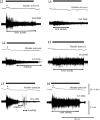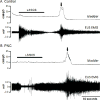Mapping and neuromodulation of lower urinary tract function using spinal cord stimulation in female rats
- PMID: 29530711
- PMCID: PMC5955844
- DOI: 10.1016/j.expneurol.2018.03.007
Mapping and neuromodulation of lower urinary tract function using spinal cord stimulation in female rats
Abstract
Spinal cord epidural stimulation (SCS) represents a form of neuromodulation for the management of spasticity and pain. This technology has recently emerged as a new approach for potentially augmenting locomotion and voiding function in humans and rodents after spinal cord injury. However, the effect of SCS on micturition has not been studied extensively. Here, SCS was first applied as a direct stimulus onto individual segmental levels of the lumbar spinal cord in rats to map evoked external urethral sphincter (EUS) electromyography activity and SCS-induced voiding contractions. SCS of L2-3 inhibited EUS tonic activity, and SCS on L3 (L3/SCS) inhibited EUS tonic activity and elicited EUS bursting. In contrast, SCS of L1 and L4-6 evoked EUS tonic contractions, which resembled the urethral guarding reflex during bladder storage. Next, the effects of a bilateral pelvic nerve crush (PNC) injury on urodynamic function were examined at 14 days post-operatively. The PNC injury resulted in decreased voiding efficiency and maximum intravesical pressure, whereas the post-voiding residual volume was increased, suggestive of an underactive bladder. Finally, L3/SCS was performed to induce a voiding contraction and enable voiding in rats with a PNC injury. Voiding efficiency was significantly increased, and the residual volume was decreased by L3/SCS in rats after the PNC injury. We conclude that L3/SCS may be used to induce micturition reflexes in a partially filled bladder, reduce urethral resistance, and augment bladder emptying after PNC injury.
Keywords: Electromyography; External urethral sphincter; Pelvic nerve; Underactive bladder.
Copyright © 2018 Elsevier Inc. All rights reserved.
Figures



References
-
- Chang HY, Cheng CL, Chen JJ, de Groat WC. Roles of glutamatergic and serotonergic mechanisms in reflex control of the external urethral sphincter in urethane-anesthetized female rats. American journal of physiology. Regulatory, integrative and comparative physiology. 2006;291:R224–234. - PMC - PubMed
Publication types
MeSH terms
Grants and funding
LinkOut - more resources
Full Text Sources
Other Literature Sources
Medical

